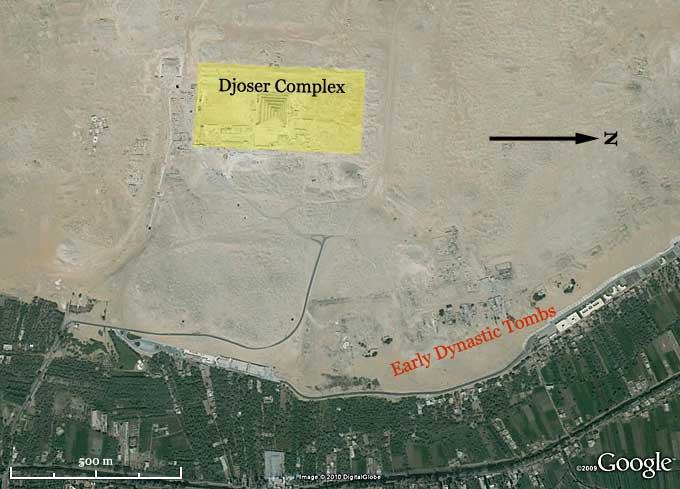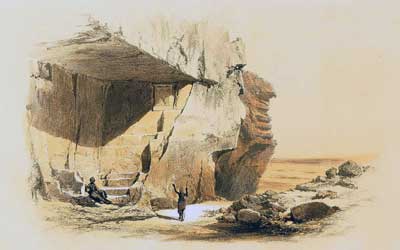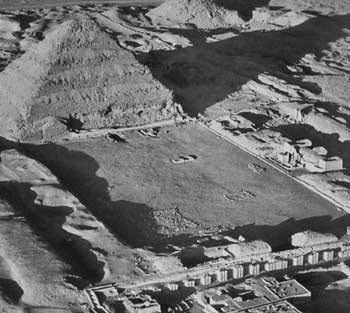
The king Zoser statue 3rd dynasty OLd Kingdom (painted lime stone 2700 B.C) at the Egyptian museum in Cairo
Netjerikhet Djoser was the 2nd King of Egypt's 3rd Dynasty, and was probably the most famous king during this period. He is also sometimes referred to as Zoser, and by the Greeks, Tesorthos. Through contemporary sources, he is only known by his Horus and Nebt-names, Netjerikhet, "the divine of body". Djoser may have been the king's birth name and appears only in later records. The earliest evidence that the two names belong to the same king is found on a long inscription on a large rock on the island of Sehel at Aswan.
According to the Turin King list, Netjerikhet Djoser ruled for about 19 years, following the 20 year long reign of the otherwise unattested Nebka (Sanakhte). However, some archaeological sources have shown that Djoser may be considered as the first king after Khasekhemwii, the last king of the 2nd Dynasty. The order by which some predecessors of Kheops are mentioned on the Papyrus Westcar may confirm that Nebka must be placed between Djoser and Huni and not before Djoser. The fact that the Turin King list has noted Djoser's name in red may also be significant, indicating a reverence for this king late into Egypt's history
Nimaathapu (Nimaethap), the wife of Khasekhemwi, is known to have held the title "Mother of the King". This makes it likely that Netjerikhet Djoser was her son, with Khasekhemwi his father. Three royal women are known from during his reign, including Inetkawes, Hetephernebti and a third one whose name is destroyed. One of them might have been his wife while the others were perhaps daughters or sisters. The relationship between Netjerikhet and his traditional successor, Sekhemkhet is not known.
It is possible that during Djoser’s reign the king managed to extend Egypt's southern border as far as Elephantine at the Nile's First Cataract. The inscription near modern Aswan on the Island of Sehel, which is a Ptolemaic forgery cut by the priests of the god Khnum of Elephantine, lays claim to some 137 km (85 miles) of territory south of their temple, known as the Dodekaschoinoi. This claim is made under the authority of Djoser, who, the inscription reads, was advised by Imhotep, his famous vizier, to make the grant of land to the temple of Khnum in order to end a famine in Egypt. In part, the text, written during the time of Ptolemy V. Epiphanes over 2000 years after the death of Djoser, partly states:
"My heart was in sore distress, for the Nile had not risen for seven years. The grain was not abundant, the seeds were dried up, everything that one had to eat was in pathetic quantities, each person was denied his harvest. Nobody could walk any more; the old people's hearts were sad and their legs were bent when they sat on the ground, and their hands were hidden away. Even the courtiers were going without, the temples were closed and the sanctuaries were covered in dust. In short, everything in existence was afflicted."
The text goes on to record Djoser's attempt to find the origins of the Nile flood and to understand the role played by Khnum in the inundation. He then makes an offering to Khnum, and the god appears to him in a dream, promising,
"I will cause the Nile to rise up for you. There will be no more years when the inundation fails to cover any area of land. The flowers will sprout up, their stems bending with the weight of the pollen."
Ptolemy V Epiphanes was no doubt actually referring to himself in the guise of Djoser, having to struggle with the effects of a famine. Regardless of whether there was a famine in Djoser's time, this stele is evidence of Djoser's continuing fame throughout Egypt's dynastic period. Also important is the fact that Ptolemy V Epiphanes was making an attempt to identify himself with Djoser, who Egyptians saw as an idea king and the founder of the Memphite dynasty. Later kings would imitate much about Djoser, and generally regard him as a king they wished to be associated with.
Netjerikhet Djoser’s foreign policy was one of careful establishment of Egyptian presence in economically important places. He sent several military expeditions to the Sinai, during which the local Bedouins were defeated, and an inscription at Wadi Maghara would indicate that he also had turquoise mined in the region. The Sinai owed its importance to the Egyptian economy for its valuable minerals turquoise and copper. It was also strategically important as a buffer between the Asian Bedouin and the Nile valley.

View of Saqqara
The site chosen for the tomb was Saqqara, which lay to the west of the Egyptian capital city of Memphis. The location was symbolic. Memphis was located at the junction of the Delta and the Nile Valley, of Upper and Lower Egypt. Saqqara had been used as cemetery ever since the foundation of the city. Silhouetted along a ridge running along the edge of the desert and highly visible from the city was a line of mastabas associated with the kings of Dynasties I. However, by Djoser’s day they all lay in ruins, destroyed during the excesses of the recent civil wars. He planned to build his funerary monument (it was more than just a tomb) on the highest part of the site and and designed it to combine elements from earlier tombs and funerary palaces. The plan grew in size and complexity as the project went on, and eventually covered an area of over 15 hectares (544 x 277 metres).
Imhotep
The project envisioned by Djoser was unprecedented and presented huge logistical problems. Fortunately, the right man for the job was at hand, his vizier Imhotep. According to his own inscriptions, he was,

Chancellor of the king of Lower Egypt, pre-eminent after the king of Upper Egypt, hereditary prince, controller of the palace, great seer [High Priest of Heliopolis], Imhotep, builder and sculptor.
His reputation among later Egyptians, especially the Ptolemies, was such that he was worshipped as a god, the son of Ptah and there were shrines to him throughout the country. Manetho wrote that during Djoser’s day,
... there lived Imouthes who from his skill in medicine was regarded as Asclepios among Egyptians. He discovered the building technique of carved stones and also applied himself to writing.
To develop a tradition of stone masonry virtually overnight, as Imhotep apparently did, was an amazing acheivement. It required precision cutting and dressing of the stone so that they were all of standard sizes. Unlike shovelling mud into wooden forms, these were skills that took time to learn. There were stone carvers about, making items such as stelae, stone bowls and cosmetic palettes, but they were relatively few in number and hundreds more would have to be trained in order to finish the job.
Quarrying and transporting the stone would involve the labour of even more people. Most of the

stone was found at the site but the fine limestones used for the outer casing had to be brought from the quarries at Tura (left) on the opposite side of the river. All of these people had to be housed and fed, involving troops of bakers, butchers, and brewers.
Coordinating these activities was a small army of scribes and managers at all levels. While writing had existed in Egypt for several centuries by this point, it had mainly been a matter of inventories and religious dedications. This project involved the transmission of precise instructions from one part of the country to another. Henceforward, there would be a highly skilled bureaucracy available to the central government that could be applied to any project.
Imhotep was almost certainly buried somewhere close to his master, as was the custom in those days, but his tomb has yet been discovered.
The Djoser Complex
When it was complete, the complex covered just over 15 hectares and contained a number of different elements. Obviously, the step pyramid was the dominant element, towering some 60 metres above the plain. At the time of its completion, it was the tallest structure in Egypt, perhaps even in the world, and would have dominated the western skyline when view from the capital city of Memphis. In addition, there were large courtyards to the north and south of the pyramid, a number of temples, shrines and other buildings, and a southern tomb. The whole thing was enclosed by massive limestone walls over 10 metres high and studded with towers.
Back to
The Beginning: Third Dynasty
Ancient Egypt








0 التعليقات:
إرسال تعليق